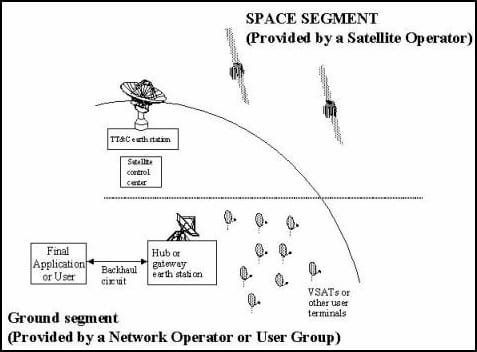The areas of our attention and expertise extend throughout the satellite system, comprised of the Space Segment (GEO, MEO or LEO) and the Ground Segment. In particular, the Ground Segment that we address comprises a number of gateway or teleport earth stations connected to land-based terrestrial network resources (e.g., the Internet) through a backhaul circuit (typically fiber); and a multiplicity of user terminals which can be either fixed at customer/end user locations or onboard various types of mobile platforms (vehicles, vessels and aircraft). These are defined in the following figure.

The Ground Segment, which is the domain of the earth station operator or network service provider, is potentially more complex because success requires that many factors be addressed correctly (or at least better than your competitor or opponent).
The Ground Segment in the first figure contains many user terminals – illustrated by very small aperture terminals (VSATs) – and a single hub earth station that ties the network together in the form of a star. Likewise, this architecture may be used to deliver digital content such as television programs, audio services, web pages, and innovative forms of multi-media. Content Distribution Networks of this type should be designed as a consistent whole, based on the application requirements and existing and evolving standards for compression and efficient data management. Also to be considered are the satellites available vs. those to be developed to provide space segment service.
The alternative to the star VSAT network is to use a mesh architecture that allows direct communication between remote earth stations without passing through a hub. Depending on the design of the space segment and air interface, other types of user terminals that could be employed include: lap-top and hand-held satellite telephones, broadband data modems for PCs, TV receivers, and video teleconferencing terminals. Equipment for the ground segment is supplied by a variety of manufacturers and integrators, including specialists in satellite communications and, in some cases, more familiar communications and consumer electronics firms in the global marketplace. Selecting among these sources is perhaps the largest single challenge because it is a strategic decision not easily reversed once the network is established.
Important factors for the Ground Segment include:
- Understanding the market and what customers want to achieve in their business
- Offering a package of services that solves communications problems or deliver content to a hungry marketplace.
- Having a solid technical platform that extends services to users on a straightforward, economical and reliable basis.
- Obtaining local approval to provide service and the establish the physical means of its delivery.
- Introducing the necessary user equipment and service through effective channels of distribution and fulfillment.
- Implementing appropriate operation and administrative systems, including customer care, accounting and billing.
- Timely entry in domestic and international markets, taking account of regulatory, business and cultural barriers.
We are able to help define the ground segment architecture, technical specifications, organization structure, and management systems to address the application requirements. This is an every-changing landscape of technology (hardware and software) and management methodology. Currently, the most popular satellite network technology is the compact user terminal, now available in fixed and mobile installations.
Fundamental to the proper specification of satellite communications is the performance of the radio frequency (RF) link between earth and space. The link budget process, reviewed under our Education and Training tab, provides the most basic understanding of the earth station-to-satellite path. In addition, the distortion characteristics of non-linear amplifiers (TWTA, SSPA and klystron) impact different waveforms in different ways. Further complicating the study is the interaction of these properties on the ground and in space. The link budgeting process may have to be supplemented by computer simulation and hardware measurement in the laboratory or with a real satellite constellation. Optical communication principles and link budgeting is involved in the context of optical inter-satellite links.
Radio frequency spectrum is a valuable resource and, of necessity, is shared between common users and with others that may have very different parameters. Radio Frequency Interference (RFI) is one category of the much broader field of Electromagnetic Interference (EMI) and Electromagnetic Compatibility (EMC), Application Technology strategy has been heavily involved with all aspects of RFI identification and resolution, as applied in wireless systems and satellite communications. Bruce Elbert has written a resource for understanding RFI, “Radio Frequency Interference in Communications Systems” available from Artech House.
Whether using video networks, user terminals or major gateways, the key to success is always to set the requirements early on, update those requirements as more is learned, and employ the right implementation methodology along a path of quick adaptation to evolving requirements, users and markets.